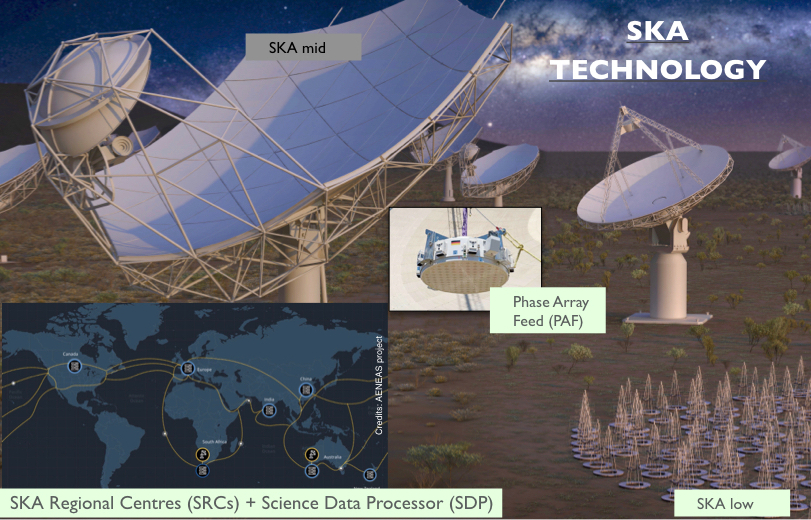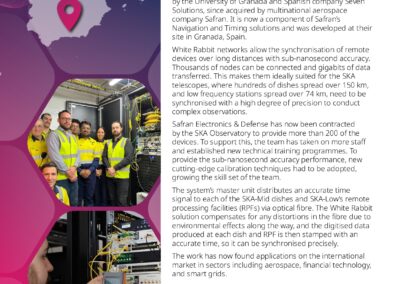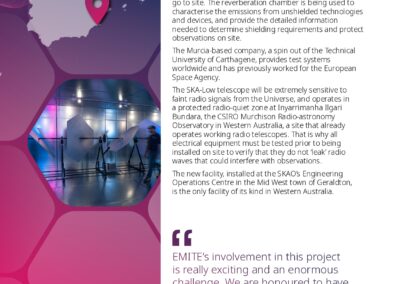Participation in the SKA design and construction

Background, SKA artistic composition at night showing SKA-Mid and SKA-Low (Credits: SKA Observatory). Center, image of a Phased Array Feed (Credits: CSRIO). Lower left, world map of the SKA Regional Centres Network that will receive the data from the Science Data Pocessor (Credits: AENEAS)
The construction and design of the SKA telescopes is an unprecedented technological challenge, involving more than 1000 scientists and engineers from more than 20 countries and 270 institutions across all continents. A total of 12 Spanish centres and 12 companies have participated in 8 of the 12 international SKA design consortia, from the beginning of the design phase until the closure of the design consortia once the System Critical Design Review was successfully passed (2013-2019): Dish, Central Signal Processor, Signal and Data Transport, Telescope Manager, Science Data Processor, Infrastructure Australia, Infrastructure South Africa and Phased Array Feeds. Participating institutions: Barcelona Supercomputing Center (BSC), Fundación Centro de Supercomputación Castilla y León (FCSCL, now SCAYLE), Instituto de Astrofísica de Andalucía (IAA-CSIC), Instituto de Ciencias del Espacio (ICE-CSIC), Instituto de Física de Cantabria (IFCA-CSIC/UC), Instituto Geográfico Nacional (IGN-OAN), Plataforma Solar de Almería (PSA-CIEMAT), Univ. de Cantabria (UC), Univ. de Granada (UGR), Univ. Politécnica de Madrid (UPM), Univ. Pública de Navarra (UPNA), and Univ. Politécnica de Valencia (UPV). Companies: Anteral, Aora Solar Spain, Arraela, CSP Sunless, Das Photonics, GMV, GTD, iGrid-TD, ISDEFE, Seven Solutions, Torresol Energy y TTI Norte.
The following technologies have been developed and applied to the SKA project by the aforementioned companies and institutions:
- Frequency and time signal distribution: Development of the White Rabbit technology for time and frequency distribution aimed at: i) improving reliability (x4); ii) developing a prototype for 10G support for both data and synchronisation; and iii) improving the firmware, equipment management, monitoring tools as well as different interoperability aspects.
- Scientific reproducibility: Contribution to developing Open Science technologies for the SKA Observatory (SKAO) telescopes, e.g., by studying how to incorporate the Data Provenance information from its Science Data processor (SDP) or the definition of the data models and the characterisation of the SDP data so that they are interoperable with Virtual Observatory standards.
- Band receivers: Developments of the cryogenic low noise amplifiers for frequencies between 2.8-15.3 GHz.
- Phased Array Feeds (PAF): Development of cryogenically cooled feeds using cryogenic technology based on Pulsating Heat Pipes (PHPs), which provide high thermal conductivity and significantly increased efficiency. Also, technologies have been developed for electronic sky rotation, local monitoring and control for the digital back-end, and receiver measurements to be applied to PAF technology.
- Scientific platforms: Contribution to build the European Open Science Cloud (EOSC) and the SKA Regional Centres international network (SRCNet). The team for the Spanish Prototype of SKA Regional Centre (espSRC) is developing and prototyping data distribution for the archives, JupyterHub services, testing SKA precursor and pathfinder data processing pipelines, and studying data transfer quality between different international research centres.
- FPGA design: Development of a digital resampler using FPGAs (Field Programmable Gate Arrays) and designing its algorithms. This includes not only detailed design but also assembly, integration, and validation services.
- Renewable Energies: Canalización de la experiencia tecnológica de España en el campo de energías renovables para que se den a conocer en el marco del SKAO. Se participó además en el proyecto europeo ‘Biostirling4SKA: Improved efficiency and cost reduction of solar dish systems, with a pilot application as renewable energy option for the SKA telescope (FP7-309028)’(link to documentary made as part of the project). led by a Spanish company, aimed at studying the implementation of a new generation of Stirling-type solar dish plants based on hybridisation and efficient storage on an industrial scale.
SKA construction began in July 2021, following its approval by the Observatory Council. This phase will last about 8 years and will be delivered in stages, each stage deploying a certain functionality as new arrays of antennas or Array Assemblies (AA) are integrated. The scientific community will begin to use these AA as they become operational, to carry out verifications not only for the instrument itself, but for the delivered scientific data. Science verification is foreseen to begin in 2026-2027. The Spanish Ministry of Science,Innovation and Universities (MICIU) announced an initial contribution of 41.4 million euros for the first 10 years for the SKA construction and operations. In March 2023, the Spanish Council of Ministers approved Spain's accession to the intergovernmental organisation, which became effective in June of the same year. This allows Spanish industry to bid for the different telescope construction contracts, previously agreed between the SKAO Council and Spain, in different areas. These areas include signal synchronisation and distribution, the construction of the sub-reflectors for the SKA-Mid dish antennas and different elements for the Band 1 and Band 5 receivers. Up until 2024, the signal synchronisation and distribution and the Band 1 control electronic package contracts have already been awarded to two national companies, and another two have been granted operations contracts through a competitive process. The tendering process for the construction contract of the sub-reflectors has also begun and several companies have already sent proposals.
Examples of Spanish industry participation in the SKA project
Credits: SKA Observatory



